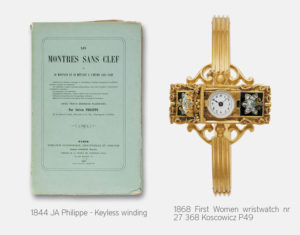Patek Philippe is one of the oldest watchmakers in the world with an uninterrupted watchmaking history since its founding in Geneva in 1839.

It has created some of the most complicated, expensive and rarest watches over the past 200 years and become an icon in the industry.
Founded by Polish watchmaker Antoni Patek and his partner Franciszek Czapek, the company originally went under the name of Patek, Czapek & Cie when it was founded in Geneva in 1839. The company began making pocket watches until 1845 when Czapek left and French watchmaking Adrien Philippe joined and the company became Patek & Cie. In 1851, as the business began to grow, it was renamed Patek Philippe & Cie. At this point, the Maison started to gain international recognition and one of its watches was purchased by Queen Victoria.

Antoni Patek
In 1877 Antoni Patek sadly passed away, but Adrien Philippe continued the business alongside his son-in-law. In 1932 the company was taken over by the Swiss Stern family. The Stern brothers’ company, Fabrique de Cadrans Sterns Frères, had been a business partner of Patek Philippe as its supplier of watch dials for many years. When they took over Patek Philippe saw huge expansion as it grew its presence in America. Patek Philippe has remained part of the Stern family ever since. In 1993, Philippe Stern, the son of Henry Stern, became the president of the company and in 2009, his son Thierry Stern took over.

Patek Philippe Museum
In recent years, Patek Philippe has grown the production of its watches slowly and it currently manufactures around 62,000 timepieces per year. A modest number that still maintains the exclusivity of the brand. Patek Philippe watches have won dozens of awards over the years and the portfolio includes some of the most expensive timepieces ever sold. Patek Philippe has invented over 20 basic calibres and has received over 100 patents in total. The brand popularized complications such as perpetual calendar, split-seconds hand, chronograph, and minute repeater in mechanical watches all of which are done in house by specialised watchmakers. This is an understated watchmaker who has continuously produced excellence for 200 years. Here we discover some of the moments that have made the Maison what it is today.
TIMELINE OF EVENTS
1839 – Patek & Czapek is established in Geneva and six months after the company is incorporated, it sells the first strike work model: a quarter-repeating pocket watch.
1851 – In London, Patek Philippe captures the attention of Queen Victoria. She acquires the dainty pendant watch No. 4719 with diamond roses on blue enamel as well as pocket watch No. 3218 with a chronometer escapement and a quarter-repeater for her husband Prince Albert.

1854 – Patek travels to The United States to acquaint the New World with his manufacture’s watches. In New York, Patek meets Charles Lewis Tiffany on December 22, 1854, and the two businessmen shake hands to forge their partnership.
1868 – Patek Philippe crafts key-wound lady’s bracelet watch No. 27 368, the first wristwatch in the history of Swiss horology. It is sold to Hungarian Countess Koscowicz in 1876.
1877 – Antoine Norbert de Patek passes away.
1902 – Patek Philippe’s double chronograph mechanism is patented.

1916 – Patek Philippe sells the first grand complication ladies’ wristwatch No. 174 603 to D.O. Wickham in New York. It was a dainty platinum watch with a five-minute repeater. Thus, Patek Philippe’s first wristwatch with a chiming mechanism is a ladies’ timepiece.
1925 – With model 97 975, Patek Philippe presents its first wristwatch with a perpetual calendar.
1953 – An automatic winding mechanism for wristwatches is patented (calibre 12-600AT).

1959 – First patent for time-zone watches based on the principle developed by Louis Cottier. Further models follow in the course of the next years.
1968 – Launch of the self-winding Golden Ellipse wristwatch Ref. 3548 with a case geometry that reflects the principle of the golden section.

1985 – Launch of the ultra-thin Ref. 3940 Perpetual Calendar that remained unchanged for more than 20 years.
1989 – Patek Philippe celebrates its 150th anniversary with the launch of the Calibre 89 pocket watch with 33 complications. It still holds the world record for complicated portable mechanical timepieces.

1996 – Move to the new manufacture complex in Plan-les-Ouates (Geneva).
2000 – Patek Philippe designs the “Supercomplication” pocket watch: the double-face half hunter Star Caliber 2000 composed of 1118 parts and featuring 21 complications, among them a Grande and Petite Sonnerie that can play the original Westminster melody on five gongs, as well as a minute repeater. The opposite face has an astronomical dial with a sky chart, and the synchronized display of the phases and angular progression of the orbiting moon.
2009 – Patek Philippe presents the first classic manually wound chronograph movement completely crafted in-house. It has a traditional column wheel as well as a horizontal clutch. The new CH 29-535 PS calibre premieres with the Ladies First Chronograph Ref. 7071 is to replace all future models formerly equipped with the outsourced Nouvelle Lémania manually wound CH 27-70 chronograph calibre.

2011 – Patek Philippe presents two grand complication ladies’ wristwatches: the Ladies First Minute Repeater Ref. 7000 and the Ladies First Split-Seconds Chronograph Ref. 7059. The manufacture’s most complicated wristwatch, an intricate ensemble of 686 individual parts, is relaunched as the Ref. 6002 in a “Rare Handcrafts” case of equal complexity with relief engravings as well as cloisonné and champlevé enamel on the dial.
2014 – Patek Philippe celebrates its 175th anniversary.
Latest Novelties

Due to the deteriorating global Covid-19 situation, Patek Philippe decided not to launch the new models in April this year as initially planned however we take a look at the most recent timepieces, launched at Baselworld 2019.















